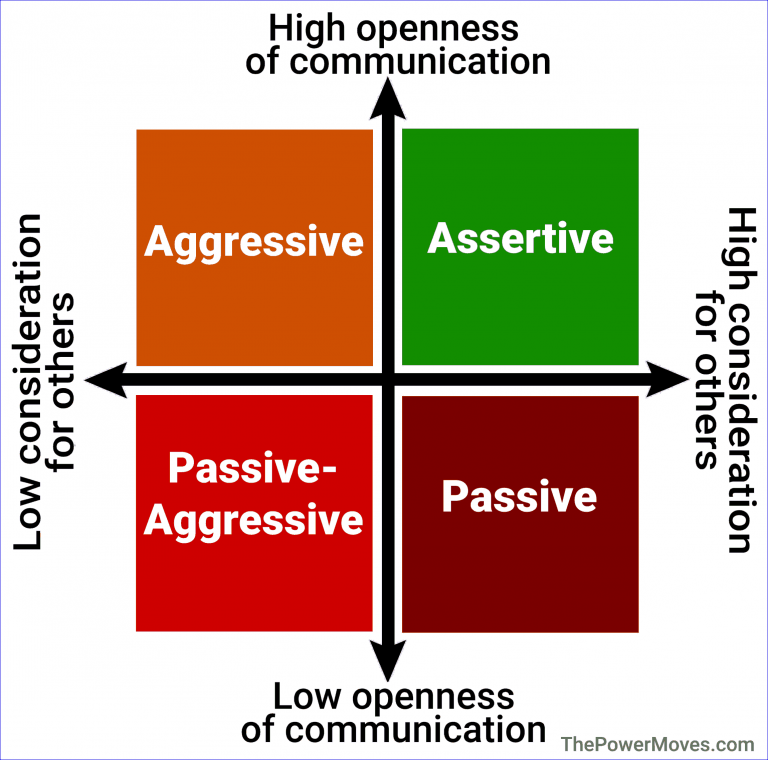Succeeding with the 5 Communication Styles You Find In Meetings
Hello friends! Please enjoy this guest post about communication styles in meetings from Ron Stefanski, website entrepreneur and marketing professor.
There are many different ways to communicate in the workplace—each with its own strengths and weaknesses. As a leader, and especially as a meeting leader, your odds of success vastly improve if you’re at ease with the different communication styles you’ll encounter.
Depending on the purpose and current focus of your meeting, you may need to listen, advise, motivate, coach, direct, or teach. Developing fluency with these different ways of communicating will help you work with your team more effectively.
Five Common Communication Styles
During meetings, you may find yourself faced with a broad range of personalities, ranging from aggressive and passive-aggressive to manipulative, and every character trait in between.

If you want to know how you can succeed in meeting goals and exceeding expectations at work, while dealing with a diverse and often conflicting range of personalities, you need to learn the different methods of communication.
This knowledge will help you manage your meetings more effectively so you can get the engaged participation and results you want from everyone involved.
Here are the different types of communication styles defined (and how to handle them in meetings).
1. Assertive Communication Style
Considered by many to be the most effective style of communication in the workplace, the assertive method is ideal for use when you are confident in your convictions and seek consensus and compromise by actively listening and clearly expressing your wants and needs.
You can handle various situations and solve problems through the proactive use of assertive communication. However, for it to be effective, you must be measured, calm, and positive. Avoid resorting to manipulation, or veering into aggressive or passive communication styles.
How to Become More Assertive in Your Communication
- Speak Confidently: High self-esteem is a hallmark of assertive communicators, and unless you’re speaking from a place of confidence, this style of communication won’t work for you. If you’re not naturally confident, but need to use this style, then you must do your best to fake it until you make it. Don’t say “should“, or “could” when you actually mean “will“. So, instead of saying “I could implement the changes”, say instead “I will implement the changes”.
- Be Solution-Oriented: Do your best to consider the needs of both you and the people with whom you are communicating. Maintain a positive attitude. Ask for the other participants’ thoughts and be sensitive to their point of view.
How to Work More Effectively with Assertive Communicators
To work better with assertive communicators, you must give them the space to talk. Let them express their ideas and solutions, all you have to do is listen.
You might prompt more information by asking them what they think, but don’t dismiss them if you think they’re being critical. With these types of communicators, if they don’t feel like you value their time, they won’t be very helpful to you.
How To Be an Assertive Communicator
In order to best lead a meeting and direct things in a timely and efficient manner, you need to be able to communicate assertively. This means being able to speak directly to aggressive communicators without becoming aggressive while elevating the voices of passive speakers without being impatient or belittling.
You have to be able to speak your truth in your voice with confidence, and you have to be able to use your voice and assertiveness to help others feel confident as well.
If you feel that you lack an assertive communication style, you can always become more assertive by consciously focusing on how you’re presenting yourself when you communicate with others. Notice when you’re being passive or when aggression takes over. Then figure out ways to control these so that your leadership isn’t hindered by passivity or hostility.
Another trick is to use tools in your meetings that can help you speak louder and more confidently than you might otherwise feel speaking.
For example, you can use PowerPoint presentations to help guide you through the meeting or even prepare short online courses in which you present information and points of discussion while educating those in the meeting about important changes they need to be aware of.
Creating these on your own is one way to be able to make sure you’re communicating assertively. You don’t have to stick with the first take. You can do many trial runs and tests to figure out the best way to present yourself assertively.
Additionally, if you’re really struggling to be assertive, you can find short PLR courses that may have just what you need to make your meeting presentations stand out.
2. Passive Communication Style
Also known as the submissive communication style, passive communication is all about “people-pleasing”.
People who use this form of communication are often easy-going, self-effacing, and always strive to avoid conflict. However, that doesn’t mean that passive communicators are always happy.
In fact, a lot of people who use this style of communication often build up resentment over time because they are unable to clearly communicate their needs, wants, and opinions.
As a leader, you may find yourself in situations where this type of communication will benefit you.
For instance, you can use it in reaction to a client who communicates in an aggressive manner. It’s also a great communication method to fall back on if all other methods of communication fail.
How to be Successful with the Passive Style
- Play to Your Strengths: If your style of communication is more passive than anything else, don’t despair. You can still communicate effectively by focusing on what you are already good at, which is compromise. Focus on looking for solutions where everyone involved can win, and then offer them up.
- Let Your Presentation Speak For You: I mentioned above that in order to create the appearance of an assertive voice you can use PowerPoint presentations, online courses, graphs, and other tools to emphasize your voice. These tools are especially effective for passive communicators, especially those who may have hidden graphic design or video editing talents. If you have trouble speaking loudly and confidently, then find a way to use your talents and tools to create a presentation that overcomes your passivity.
How to Work More Effectively with Passive Communicators
A passive communicator will often step back to allow more aggressive or assertive people to lead the way. They find it hard to express themselves, particularly in a group setting, and they will do anything possible to avoid confrontation.
Because of this, some of their best ideas are never heard, and it also makes it extremely easy for miscommunications to arise.
The video below shows an example of passive behavior:
When working with passive communicators, don’t be confrontational or angry. This will cause them to completely shut down.
Always make sure you directly ask them for their views and opinions on specific subjects. Give them enough time to properly express their ideas, and don’t dismiss any of them.
Chances are, they’re working very hard to build their confidence, and even if the idea isn’t a great fit, still you must point out the value in it and highlight its positive aspects as opposed to cutting them down with a negative objection.
If you’re in a webinar or remote meeting, make sure you choose whose microphone is turned on when. This way you can make sure the passive speaker is able to speak their great ideas without fear of someone interrupting them.
3. Aggressive Communication Style
An aggressive communicator has the same high level of confidence and self-assurance that an assertive communicator does. The main difference between the two communicators is that one considers the other person’s feelings while the other does not.
Aggressive communication often arises from wanting to win at all costs. Although it may get you the results you want, it might also leave the people you’re communicating with feeling intimidated or belittled.
That’s never good when communicating in the workplace.
Aggressive communication is often viewed as threatening and hostile, which means your message may go unheard due to the tone of your delivery.
Fortunately, there are a few ways to adjust an aggressive style in order to communicate more effectively.
How to be Successful with the Aggressive Style
- Focus on Problem-Solving vs. Winning: You need to work with others if you’re going to solve the problem. If you behave as if other people’s contributions to the conversation are less important than yours, you’re likely to fail in getting your message across properly. So, instead of putting winning first, focus more on solving problems, and this way, everyone wins.
- Tone Down the Body Language: Another way to adjust your aggressive style in order to communicate better is to take a look at your body language. For the most part, an aggressive communicator will use physical proximity, gestures, and tone of voice as a way to underline their power during the conversation. However, to communicate better, you need to step back and take it down a notch. You’ll find that your colleagues respond better to a calmer conversation style.
How to Work More Effectively with Aggressive Communicators
Working with an aggressive communicator can be challenging. If you are in a position to do so, you should strive to help them adjust their communication style by simply advising them on their behavior and introducing them to other communication styles.
If it’s not possible to help them improve their communication method, then do your best to steer them in the right direction so you can immediately get down to business. Your work will be to streamline the conversation to prevent them from wandering off into irrelevant or unpleasant topics.
Additionally, an aggressive communicator will walk all over a passive communicator if given the chance. If you see an aggressive communicator dominating the conversation and prohibiting passive communicators from speaking, you need to step in and tell the aggressive communicator to allow the other person to speak.
Do so assertively and do not meet aggression with aggression. If the meeting is being hosted remotely on a webinar platform, you may have to mute the aggressive communicator if they refuse to let others speak.
4. Passive-Aggressive
Passive-aggressive communicators combine aspects of both the passive and aggressive styles outlined above.
You may find that their passive nature exists on the surface, making the communicator seem sweet and easy-going while the aggressive side seethes beneath, which means that everything they say and do is actually coming from a place of resentment and anger.
This side of them will often bubble up and show itself through the use of sarcasm. Passive-aggressive communicators are also prone to starting rumors, gossiping, and being patronizing.
These indirect routes are the only way for them to release their frustration, but this toxic way of communicating will have the same effect as a person who is openly aggressive in that their colleagues won’t enjoy working with them.
How to be Successful with the Passive-Aggressive Style
- Adjust Your Attitude: If you consistently communicate in a passive-aggressive manner, one way to improve yourself is to ask yourself what your motivation is when you communicate. For instance, are you lashing out or do you genuinely want to help solve a problem? By adjusting the way you approach conversations, you will find it easier to focus more on positive statements that are solution-oriented instead of talking to others in a way that spreads resentment and discontent in the workplace.
- Calm Your Mind: Adjusting your attitude is honestly a lot harder than it sounds, and the truth is we might have to do some internal work to calm our minds when we find ourselves becoming passive-aggressive. What this means is that instead of just reacting or making a snide remark or gesture, you need to take a deep breath and empty out all the negative emotions and stress from your mind. Once you find a place of peace, you will be able to overcome passive-aggressive behavior much more easily. To learn about different ways you can calm your mind, check out this resource here.
How to Work More Effectively with Passive-Aggressive Communicators
If you find yourself having to deal with a passive-aggressive communicator, the first thing to do is to avoid meeting them with the same style (although this can be quite hard sometimes).
Instead, try to understand their motivations. For instance, is there an outside force that’s causing them to communicate this way? Maybe they consistently use the passive-aggressive style to deal with aggressive communicators? Whatever the reason, if it’s within your power to do so, you can help them solve that problem.
Another way to deal with passive-aggressive communicators is to focus on their core message and then rephrase it in a more assertive manner.
By changing the tone of the message, you can demonstrate the communication style that you’d prefer them to use when delivering messages.
5. Manipulative Communication Style
The manipulative style of communication makes use of deceit, influence, and cunning to control not only the conversation, but also the actions of the others involved, and ultimately the outcome of the conversation.
A manipulative communicator rarely ever says what he or she means, but instead, they will bury their actual objectives beneath tons of confusing facts and information that confuses and gets in the way of the other person – often without them even realizing it.
This communication style is insincere and patronizing, and when people realize how the manipulator played them, they won’t respond well to any future communications from that person.
As a leader, you probably already know that some manipulation can come in handy, especially in customer-facing roles where you may have to find ways to calm down irritated clients (as an example).
However, this style of communication often leads to clashes within departments or teams if one of them is using it consistently.
How to be Successful with the Manipulative Style
- Steer Toward Assertive Communication: If you often communicate in this manner, you can adjust your style to get your message across better by taking the time to prioritize everyone’s needs, instead of just your own, so you can achieve better results without upsetting others around you.
- Don’t Use Emotional Arguments: When having a conversation or argument, stick to the facts and be precise and direct your communication. Remind yourself how quickly this style of communication can breed resentment among colleagues, and as you work to adjust your communication style, keep in mind that the people around you may be a bit wary of your motivations. But, be consistent in your efforts and you’ll soon find yourself communicating a lot more effectively.
How to Work More Effectively with Passive-Aggressive Communicators
If you have to work with someone who communicates in a manipulative way, you should try to steer them toward assertive communication.
When they use emotional arguments, focus on redirecting them and don’t allow their emotional pleas to derail the conversation.
Remain patient and calm. Politely refuse to be manipulated and stick to the topic of the conversation relentlessly and they will soon realize that you aren’t an effective target for their manipulative tactics.
Conclusion
Without the right communication skills, it can sometimes feel like you’re trying to get your message across to someone from an alien species.
Use the information in this article to help you develop the critical skill of adopting your style of communication based on situational needs.
Some situations will demand certain styles, and you might find that a particular style is more effective with some employees than others. Styles can also be combined, as you can switch from one style to the other based on your needs at that moment. Being flexible is the only way to make this work effectively.
Did this article answer your questions on how you can succeed with the 5 communication styles? Share your thoughts in the comments below!



